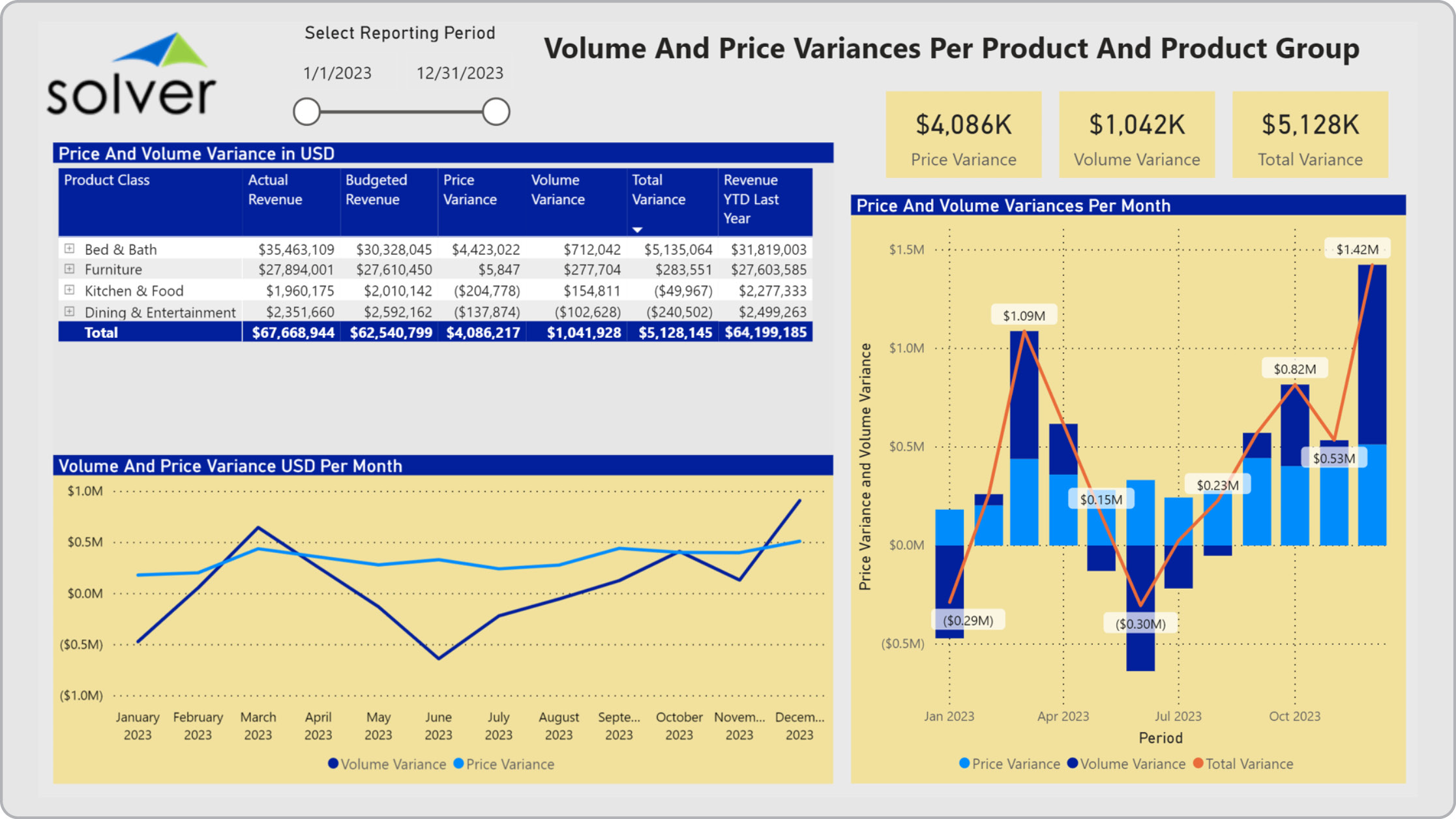Product Sales Volume and Price Variance Dashboard for Retail Companies
What is a
a Product Sales Volume and Price Variance Dashboard
? Product Sales Variance Dashboards for retail companies are considered sales analysis tools and are used by managers to analyze the main reasons product sales are above or below budget. Some of the key functionality in this type of dashboard is that it shows how much of a budget variance comes from price factors versus quantities sold. The dashboard provides four perspectives: 1) A matrix with actual, budget revenue and it shows how much of the variance comes from volume versus price, 2) Trend chart with volume and price variance per month, 3) KPIs for price variance, volume variance and total variance, and 4) Total variance trend with price and volume in monthly stacked column bars. Using the parameter slider in the top left corner, the user can quickly expand or narrow the from-to date range used in the analysis. You find an example of this type of dashboard below.
Purpose of
Product Sales Variance Dashboards Retail organizations use Product Sales Variance Dashboards to give managers deep insight into budget variances. When used as part of good business practices in Financial Planning & Analysis (FP&A) and product/sales departments, an organization can improve and speed up its product strategies and increase revenues, and it can reduce the chances that low performing items are not getting timely attention.
Product Sales Variance Dashboard
Example Here is an example of a Product Sales Variance Dashboard with break-down into price and volume metrics. [caption id="" align="alignnone" width="2233"]
 Example of a Product Sales Volume and Price Variance Dashboard for Retail Companies[/caption] You can find hundreds of additional examples
here
Who Uses This Type of
Dashboard
? The typical users of this type of dashboard are: CFOs, analysts, regional managers, ecommerce managers, price managers, product managers.
Other Reports Often Used in Conjunction with
Product Sales Variance Dashboards Progressive Financial Planning & Analysis (FP&A) departments sometimes use several different Product Sales Dashboards, along with financial dashboards, profit & loss reports, sales reports, sales forecast, annual budgets, and other management and control tools.
Where Does the Data for Analysis Originate From? The Actual (historical transactions) data typically comes from enterprise resource planning (ERP) systems like: Microsoft Dynamics 365 (D365) Finance, Microsoft Dynamics 365 Business Central (D365 BC), Microsoft Dynamics AX, Microsoft Dynamics NAV, Microsoft Dynamics GP, Microsoft Dynamics SL, Sage Intacct, Sage 100, Sage 300, Sage 500, Sage X3, SAP Business One, SAP ByDesign, Acumatica, Netsuite and others. In analyses where budgets or forecasts are used, the planning data most often originates from in-house Excel spreadsheet models or from professional corporate performance management (CPM/EPM) solutions.
What Tools are Typically used for Reporting, Planning and Dashboards? Examples of business software used with the data and ERPs mentioned above are:
Example of a Product Sales Volume and Price Variance Dashboard for Retail Companies[/caption] You can find hundreds of additional examples
here
Who Uses This Type of
Dashboard
? The typical users of this type of dashboard are: CFOs, analysts, regional managers, ecommerce managers, price managers, product managers.
Other Reports Often Used in Conjunction with
Product Sales Variance Dashboards Progressive Financial Planning & Analysis (FP&A) departments sometimes use several different Product Sales Dashboards, along with financial dashboards, profit & loss reports, sales reports, sales forecast, annual budgets, and other management and control tools.
Where Does the Data for Analysis Originate From? The Actual (historical transactions) data typically comes from enterprise resource planning (ERP) systems like: Microsoft Dynamics 365 (D365) Finance, Microsoft Dynamics 365 Business Central (D365 BC), Microsoft Dynamics AX, Microsoft Dynamics NAV, Microsoft Dynamics GP, Microsoft Dynamics SL, Sage Intacct, Sage 100, Sage 300, Sage 500, Sage X3, SAP Business One, SAP ByDesign, Acumatica, Netsuite and others. In analyses where budgets or forecasts are used, the planning data most often originates from in-house Excel spreadsheet models or from professional corporate performance management (CPM/EPM) solutions.
What Tools are Typically used for Reporting, Planning and Dashboards? Examples of business software used with the data and ERPs mentioned above are:
- Native ERP report writers and query tools
- Spreadsheets (for example Microsoft Excel)
- Corporate Performance Management (CPM) tools (for example Solver)
- Dashboards (for example Microsoft Power BI and Tableau)
Corporate Performance Management (CPM) Cloud Solutions and More Examples
March 13, 2021
TAGS:
Reporting,
Solver,
report writer,
Microsoft,
template,
practice,
Acumatica,
visualization,
Netsuite,
Finance,
planning,
GP,
dashboard,
Business Central,
excel,
ax,
forecast,
Budget,
Dynamics 365,
price,
budgeting,
Cloud,
Software,
product,
Tableau,
SAP,
example,
ecommerce,
best,
Sage,
BC,
D365,
NAV,
Intacct,
online,
Retail,
CPM,
report,
SL,
Management,
dynamics,
Power BI

